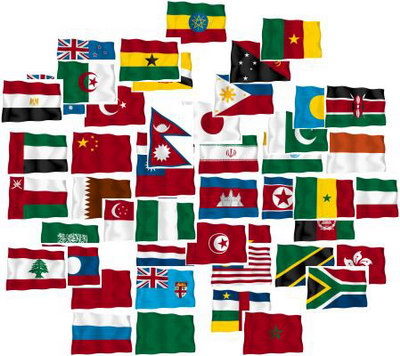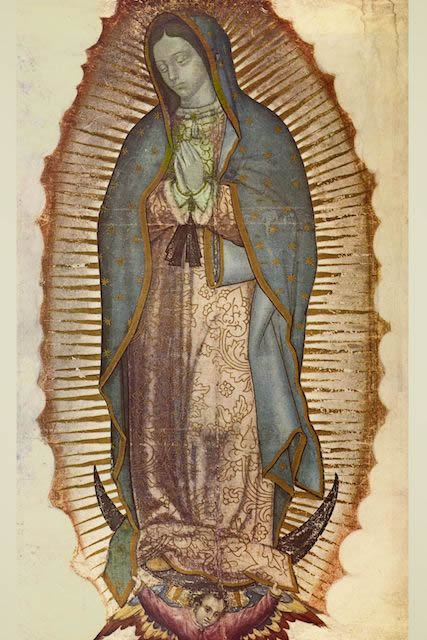
IT is one of the most remarkable ongoing miracles in modern times, and the majority of Catholics are likely unaware of it. Chapter Six in my book, The Final Confrontation, deals with the incredible miracle of the image of Our Lady of Guadalupe, and how it relates to Chapter 12 in the Book of Revelation. Due to widespread myths that have been accepted as facts, however, my original version has been revised to reflect the verified scientific realities surrounding the tilma upon which the image remains as in inexplicable phenomenon. The miracle of the tilma needs no embellishment; it stands on its own as a great “sign of the times.”
I have published Chapter Six below for those who already have my book. The Third Printing is now available for those who would like to order additional copies, which includes the information below and any typographical corrections found.
Note: the footnotes below are numbered differently than the printed copy.
CHAPTER SIX: A WOMAN AND A DRAGON
A great sign appeared in the sky, a woman clothed with the sun, with the moon under her feet, and on her head a crown of twelve stars. She was with child and wailed aloud in pain as she labored to give birth. Then another sign appeared in the sky; it was a huge red dragon, with seven heads and ten horns, and on its heads were seven diadems. Its tail swept away a third of the stars in the sky and hurled them down to the earth. (Rev 12:1-4)
IT BEGINS
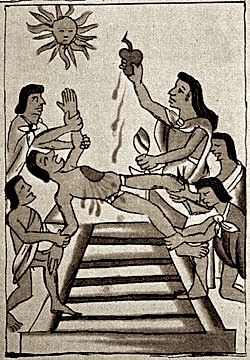 They were one of the bloodiest cultures on earth. It is estimated that the Aztec Indians, in what is known as Mexico today, sacrificed, along with the rest of Mezzo-america, as many as 250,000 lives each year. [1]Woodrow Borah, possibly the leading authority on the demography of Mexico at the time of the conquest, has revised the estimated number of persons sacrificed in central Mexico in the fifteenth century to 250,000 per year. —http://www.sancta.org/patr-unb.html The bloody rituals sometimes included removing the victim’s heart while he was still alive. They worshipped the Serpent-god Quetzalcoatl whom they believed would eventually render all other god’s useless. As you’ll see, this belief was pivotal in the eventual conversion of those peoples.
They were one of the bloodiest cultures on earth. It is estimated that the Aztec Indians, in what is known as Mexico today, sacrificed, along with the rest of Mezzo-america, as many as 250,000 lives each year. [1]Woodrow Borah, possibly the leading authority on the demography of Mexico at the time of the conquest, has revised the estimated number of persons sacrificed in central Mexico in the fifteenth century to 250,000 per year. —http://www.sancta.org/patr-unb.html The bloody rituals sometimes included removing the victim’s heart while he was still alive. They worshipped the Serpent-god Quetzalcoatl whom they believed would eventually render all other god’s useless. As you’ll see, this belief was pivotal in the eventual conversion of those peoples.
It was in the midst of this blood-soaked culture of death, in 1531 A.D.,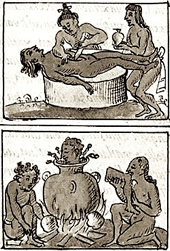 that “the Woman” appeared to a commoner there in what marks the beginning of a great confrontation with the serpent. How and when she appeared is what makes her apparition most significant…
that “the Woman” appeared to a commoner there in what marks the beginning of a great confrontation with the serpent. How and when she appeared is what makes her apparition most significant…
It was at dawn when Our Lady first came to St. Juan Diego as he walked along the countryside. She requested that a church be built on the hill where the apparitions were taking place. St. Juan approached the Bishop with her request, but was asked to return to the Virgin and appeal for a miraculous sign as proof of her appearances. So she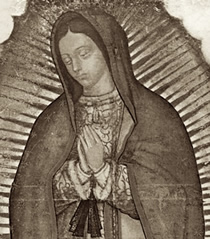 instructed St. Juan to collect flowers from the Hill of Tepeyac and bring them to the Bishop. Even though it was winter, and the ground was rough terrain, he found flowers of every kind blooming there, including Castilian roses, which were native to the Bishop’s homeland in Spain—but not Tepeyac. St. Juan gathered the flowers into his tilma. [2]tilma or “cloak” The Blessed Virgin re-arranged them and then sent him on his way. When he unfolded the tilma before the Bishop, the flowers fell to the ground, and suddenly a miraculous image of Our Lady appeared on the cloth.
instructed St. Juan to collect flowers from the Hill of Tepeyac and bring them to the Bishop. Even though it was winter, and the ground was rough terrain, he found flowers of every kind blooming there, including Castilian roses, which were native to the Bishop’s homeland in Spain—but not Tepeyac. St. Juan gathered the flowers into his tilma. [2]tilma or “cloak” The Blessed Virgin re-arranged them and then sent him on his way. When he unfolded the tilma before the Bishop, the flowers fell to the ground, and suddenly a miraculous image of Our Lady appeared on the cloth.
OUR LADY OF GUADALUPE: A LIVING IMAGE
The actual miracle was so overwhelming that the bishop never contested it. For centuries, it remained the only uncontested miracle by the Church (though in 1666, an investigation was conducted primarily for historical reference.) It is important to pause for a moment to consider the nature of this miraculous event, for it underscores the great significance of this apparition.
This cloth is among the most exceptional ongoing miracles in modern times. What I am about to explain below has been scientifically verified, and amazingly, is known by relatively few in the Church. The fact that technology is only now able, in our times, to discover some of the tilma’s miraculous elements is also significant, as I will explain.
In August of 1954, Dr. Rafael Torija Lavoignet discovered that her eyes demonstrated the Purkinje-Sanson law. That is, they contained three mirror reflections of the same image on the inner and outer cornea and outer lens surface—characteristics belonging to a human eye. This was confirmed again in 1974-75 by Dr. Enrique Graue. In 1985, hair-like images of blood vessels were discovered in the upper eyelids (which were not circulating blood, according to some rumors).
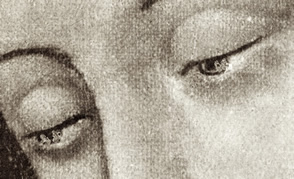 Perhaps most remarkable was the discovery, through digital technology, of human figures in her pupils that no artist could have possibly painted, particularly on such rough fibers. The same scene is reflected in each eye revealing what appears to be the instant that the image appeared on the tilma.
Perhaps most remarkable was the discovery, through digital technology, of human figures in her pupils that no artist could have possibly painted, particularly on such rough fibers. The same scene is reflected in each eye revealing what appears to be the instant that the image appeared on the tilma.
It is possible to discern a seated Indian, who is looking up to the heavens; the profile of a balding, elderly man with a white beard, much like the portrait of Bishop Zumárraga, painted by Miguel Cabrera, to depict the miracle; and a younger man, in all probability interpreter Juan González. Also present is an Indian, likely Juan Diego, of striking features, with a beard and mustache, who unfolds his own tilma before the bishop; a woman of dark complexion, possibly a Negro slave who was in the bishop’s service; and a man with Spanish features who looks on pensively, stroking his beard with his hand. —Zenit.Org, January 14th, 2001
The figures are located exactly where they are supposed to be in both eyes, with distortion in the images agreeing with the curvature of a human cornea. It’s as though Our Lady had her picture taken with the tilma acting as a photographic plate, her eyes bearing the scene of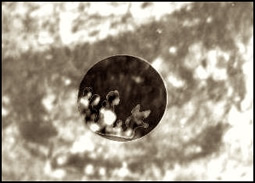 what occurred at the moment the image appeared in front of the Bishop.
what occurred at the moment the image appeared in front of the Bishop.
Further digital enhancements have found an image, independent of the other, situated in the center of her eyes. It is that of an Indian family made up of a woman, a man and several children. I will discuss the significance of this later on.
The tilma is made of ayate, a coarse fabric woven from ixtle plant fibers. Ric hard Kuhn, a Nobel Prize winner in chemistry, has found that the original image does not have natural, animal, or mineral colorings. Given that there were no synthetic colorings in 1531, the source of the pigments is inexplicable. Zenit News Agency reports that in 1979, Americans Philip Callahan and Jody B. Smith studied the image using infrared rays and also discovered, to their surprise, that there was no trace of paint or brush strokes, and that the fabric had not been treated with any kind of technique. There is no thickness to the pigmentation, so there is not the usual aspect that we are used to seeing in, say, an oil painting where colors “melt” together. The ixtle fibers are also visible through parts of the image; that is, the holes of the fabric are visible through the pigmentation giving the sense that the image “hovers,” though it is indeed touching the fabric.
Presenting these facts at a Pontifical conference in Rome, a Peruvian environmental systems engineer asked:
[How] it is possible to explain this image and its consistency in time without colors, on a fabric that has not been treated? [How] is it possible that, despite the fact there is no paint, the colors maintain their luminosity and brilliance? —José Aste Tonsmann, Mexican Center of Guadalupan Studies; Rome, January 14th, 2001; Zenit.org
Furthermore, when consideration is given to the fact that there is no under-drawing, sizing, or over-varnish, and that the weave of the fabric is itself utilized to give the portrait depth, no explanation of the portrait is possible by infrared techniques. It is remarkable that, in over four centuries, there is no fading or cracking of the original figure on any portion of the ayate tilma, which being unsized, should have deteriorated centuries ago. —Dr. Philip C. Callahan, Mary of the Americas, by Christopher Rengers, OFM Cap., New York, St. Pauls, Alba House, 1989, p. 92f.
Indeed, the tilma appears to be somewhat indestructible. Ayate cloth has a normal lifespan of no more than 20-50 years. In 1787, Dr. Jose Ignacio Bartolache made two copies of the image, trying to recreate the original as accurately as possible. He placed two of these copies in Tepeyac; one in a building called El Pocito, and the other in the sanctuary of St. Mary of Guadalupe. Neither lasted even ten years, underscoring the astonishing incorruptibility of the original image: it has been over 470 years since Our Lady appeared on St. Juan’s tilma. In the year 1795, nitric acid was accidentally spilled on the upper right side of the tilma, which should have dissolved those fibers. However, a mere brownish stain is left on the fabric that some claim is lightening over time (though the Church has made no such claim.) On one infamous occasion in 1921, a man concealed a high-powered bomb in a flower arrangement and placed it at the feet of the tilma. The explosion destroyed parts of the main altar, but the tilma, which should have sustained damage, remained completely intact. [3]See www.truthsoftheimage.org, an accurate website produced by the Knights of Columbus
While these technological discoveries speak more to modern man, the imagery on the tilma is what spoke to the Mezzo-american peoples.
The Mayans believed that the gods sacrificed themselves for men, and thus, man must now offer blood through sacrifice in order to keep the gods alive. On the tilma, the Virgin is wearing a customary Indian band indicating that she is with child. The black colored band is exclusive to Our Lady of Guadalupe because black is the color used to represent Quetzalcoatl, their god of creation. The black bow is tied in four loops like a four-petal flower that would have symbolized to the indigenous people the dwelling place of God and the genesis of creation. Thus, they would have understood this Woman—pregnant with a “god”—to be greater than Quetzalcoatl. Her gently bowed head, however, showed that the One she carried was greater than her. Thus, the image “evangelized” the Indian peoples who came to understand that Jesus—not Quetzalcoatl—was the God who renders all others useless. St. Juan and the Spanish missionaries could then explain that His Bloody Sacrifice was the only one necessary…
BIBLICAL IMAGERY
Let us return again to Revelation 12:
A great sign appeared in the sky, a woman clothed with the sun, with the moon under her feet, and on her head a crown of twelve stars.
When St. Juan first saw Our Lady on Tepeyac, he gave this description:
…her clothing was shining like the sun, as if it were sending out waves of light, and the stone, the crag on which she stood, seemed to be giving out rays. —Nican Mopohua, Don Antonio Valeriano (c. 1520-1605 A.D,), n. 17-18
The image seems to portray this scene as rays of light extend all around the tilma.
She glowed with the perfection of her beauty and her countenance was as joyous as it was lovely… (Esther D:5)
It has been discovered that the stars on Our Lady’s mantle are positioned just as they would have appeared in the sky in Mexico on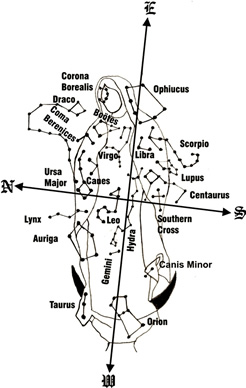 December 12, 1531 at 10:40 am, with the eastern sky above her head, and the northern sky to her right (as though she were standing on the equator). The constellation Leo (Latin for “lion”) would have been at the highest point in its zenith meaning that the womb and the four petal flower—the center of creation, the dwelling place of God—is situated directly over the apparition site, that is today, the Cathedral in Mexico City where the tilma now hangs. Not coincidentally, on that same day, star maps show that there was a crescent moon in the sky that evening. Dr. Robert Sungenis, who studied the relation of the tilma to the constellations at that time, concluded:
December 12, 1531 at 10:40 am, with the eastern sky above her head, and the northern sky to her right (as though she were standing on the equator). The constellation Leo (Latin for “lion”) would have been at the highest point in its zenith meaning that the womb and the four petal flower—the center of creation, the dwelling place of God—is situated directly over the apparition site, that is today, the Cathedral in Mexico City where the tilma now hangs. Not coincidentally, on that same day, star maps show that there was a crescent moon in the sky that evening. Dr. Robert Sungenis, who studied the relation of the tilma to the constellations at that time, concluded:
As the number and placement of the stars on the tilma can be the produce of none other than a divine hand, the materials employed to make the image are literally out of this world. —New Discoveries of the Constellations on the Tilma of Our Lady of Guadalupe, Catholic Apologetics International, July 26, 2006
Interpolating from the “map” of stars on her mantle, remarkably, the Corona Borealis (Boreal Crown) constellation is located exactly over the Virgin’s head. Our Lady is literally crowned with stars according to the pattern on the tilma.
Then another sign appeared in the sky; it was a huge red dragon, with seven heads and ten horns, and on its heads were seven diadems. Its tail swept away a third of the stars in the sky and hurled them down to the earth. Then the dragon stood before the woman about to give birth, to devour her child when she gave birth. (Rev 12:3-4)
The constellations reveal more, in particular, the presence of a confrontation with evil:
Draco, the dragon, Scorpios, the stinging scorpion, and Hydra the serpent, are off to the north, south and west, respectively, forming a triangle, or perhaps a mock trinity, surrounding the woman from all sides, except heavenward. This represents Our Lady being in a constant battle with Satan as described in Rev 12:1-14, and perhaps coincident with the dragon, the beast, and the false prophet (cf. Rev 13:1-18). In fact, Hydra’s tail, which appears fork-shaped on the image, is just below Virgo, as if it is waiting to devour the Child to whom she will give birth… —Dr. Robert Sungenis, —New Discoveries of the Constellations on the Tilma of Our Lady of Guadalupe, Catholic Apologetics International, July 26, 2006
THE NAME
Our Lady also revealed herself to St. Juan’s ill uncle, instantly healing him. She called herself “Santa Maria Tecoatlaxopeuh”: The Perfect Virgin, Holy Mary of Guadalupe. However, “Guadalupe” is Spanish/Arabic. The Aztec Nahuatl word “coatlaxopeuh,” which is pronounced quatlasupe, sounds remarkably like the Spanish word “Guadalupe.” The Bishop, who did not know the Nahuatl language, assumed the uncle meant “Guadalupe,” and the name “stuck.”
The word coa means serpent; tla, being the noun ending, can be interpreted as “the”; while xopeuh means to crush or stamp out. So some suggest that Our Lady might have called herself the one “who crushes the serpent,” [4]http://www.sancta.org/nameguad.html; cf. Gen 3:15 though that is a later Western interpretation. Alternatively, the word Guadalupe, borrowed from the Arabs, means Wadi al Lub, or river channel—”that which leads the water.” Thus, Our Lady is also seen as the one who leads to the water… the “living waters” of Christ (Jn 7:38). By standing on the crescent moon, which is a Mayan symbol of the “god of the night”, the Blessed Mother, and thus the God she carries, is shown to be more powerful than the god of darkness. [5]The Symbolism of the Image, 1999 Office of Respect Life, Diocese of Austin
Through all of this rich symbolism, the apparitions and tilma helped bring about the conversion of some 7-9 million indigenous within a decade, putting an end to human sacrifice there. [6]Tragically, at the time of this publishing, Mexico City has chosen to restore human sacrifice by making abortion legal there in 2008. While many commentators look to the events and culture of death prevalent at the time of this apparition as being the reason for our Mother’s appearance there, I believe there is a much greater and eschatological significance that goes beyond the Aztec culture. It has to do with a serpent beginning to slither in the tall, cultural grasses of the Western world…
THE DRAGON APPEARS: SOPHISTRY
Satan rarely ever manifests himself. Instead, like the Indonesian Komodo Dragon, he hides, waiting for his prey to pass by, and then strikes them with his deadly venom. When the prey has been overcome by his poison, the Komodo returns to finish it off. Likewise, only when societies have fully succumbed to Satan’s poisonous lies and deceptions does he finally rear his head, which is death. It is then we know that the serpent has revealed himself to “finish off” his prey:
He was a murderer from the beginning… he is a liar and the father of lies. (John 8:44)
Satan plants his lie, and the fruit of it is death. On a societal level, it becomes a culture at war with itself and others.
By the envy of the devil, death came into the world: and they follow him that are of his side. (Wis 2:24-25; Douay-Rheims)
In 16th century Europe, shortly after Our Lady of Guadalupe appeared, the red dragon began to re-introduce his ultimate lie into the human mind: that we too can “be like gods” (Gen 3:4-5).
Then another sign appeared in the sky; it was a huge red dragon…
The previous centuries had prepared the soil for this lie as schism in the Church undermined her authority, and misuse of power damaged her trustworthiness. Satan’s objective—to become the object of worship in place of God [7]Revelation 13:15—begins subtly since, at that time, you would be considered odd not to believe in God.
The philosophy of deism was introduced by English thinker Edward Herbert (1582-1648) in which the belief of a Supreme Being was kept intact, but without doctrines, without churches, and without public revelation:
God was the Supreme Being who designed the universe and then left it to its own laws. —Fr. Frank Chacon and Jim Burnham, Beginning Apologetics 4, p. 12
The fruit of this thinking is immediately self-evident: progress becomes the new form of human hope, with “reason” and “freedom” as its guiding stars, and scientific observation its foundation. [8]Pope Benedict XVI, Spe Salvi, n. 17, 20 Pope Benedict XVI points out the deception from its beginnings.
This programmatic vision has determined the trajectory of modern times… Francis Bacon (1561—1626) and those who followed in the intellectual current of modernity that he inspired were wrong to believe that man would be redeemed through science. Such an expectation asks too much of science; this kind of hope is deceptive. Science can contribute greatly to making the world and mankind more human. Yet it can also destroy mankind and the world unless it is steered by forces that lie outside it. —Encyclical Letter, Spe Salvi, n. 25
And so this new worldview evolved and mutated, reaching further and further into man’s activities. While there was a noble pursuit of truth, philosophers began to discard theology as a superstitious myth. Leading thinkers began to evaluate the world around them exclusively by what they could measure and empirically validate (empiricism). God and faith cannot be measured, and were thus ignored. At the same time, however, desiring to keep at least some strands of connection to the idea of the divine, the Father of Lies re-introduced the ancient idea of pantheism: the belief that God and creation are one. This concept stems from Hinduism (it is interesting that one of the major Hindu gods is Shiva who appears with a crescent moon on his head. His name means “destroyer or transformer”.)
One day out of the blue, the word “sophistry” entered my mind. I looked it up in the dictionary and discovered that all of the above philosophies, and others that were introduced during this period in history, fall precisely under this title:
sophistry: a deliberately invalid argument displaying ingenuity in reasoning in the hope of deceiving someone.
By this I mean that good philosophy was injected with sophistry—human “wisdom,” which leads away from God, rather than to Him. This satanic sophistry eventually reached critical mass in what is called “The Enlightenment.” It was an intellectual movement that began in France and swept throughout Europe in the 18th century, radically transforming society and, ultimately, the modern world.
The Enlightenment was a comprehensive, well-organized, and brilliantly led movement to eliminate Christianity from modern society. It began with Deism as its religious creed, but eventually rejected all transcendent notions of God. It finally became a religion of “human progress” and t he “Goddess of Reason.” —Fr. Frank Chacon and Jim Burnham, Beginning Apologetics Volume 4: How to Answer Atheists and New Agers, p.16
This separation between faith and reason gave birth to new “isms.” Of note:
Scientism: proponents refuse to accept anything that cannot be observed, measured, or experimented upon.
Rationalism: the belief that the only truths we can know with certainty are gained through reason alone.
Materialism: the belief that the only reality is the material universe.
Evolutionism: the belief that the evolutionary chain can be completely explained by random biological processes, excluding the need for God or God as its cause.
Utilitarianism: the ideology that actions are justified if they are useful or a benefit for the majority.
Psychologism: the tendency to interpret events in subjective terms, or to exaggerate the relevance of psychological factors. [9]Sigmund Freud was the father of this intellectual/psychological revolution, which could also be called Freudianism. He was known to have said, “Religion is nothing but an obsessive-compulsive neurosis.” (Karl Stern, The Third Revolution, p. 119)
Atheism: the theory or belief that God does not exist.
These beliefs culminated in the French Revolution (1789-1799). The divorce between faith and reason progressed to a divorce between Church and State. “The Declaration of the Rights of Man” was drawn up as a preamble to France’s constitution. Catholicism ceased to be the religion of the state; [10]The Declaration of Rights mentions in its preamble that it is made in the presence and under the auspices of the Supreme Being, but out of three of the articles proposed by the clergy, guaranteeing the respect due to religion and public worship, two were rejected after speeches by the Protestant, Rabaut Saint-Etienne, and Mirabeau, and the only article relating to religion was worded as follows: “No one shall be disturbed for his opinions, even religious, provided their manifestation does not disturb the public order established by law.” —Catholic Online, Catholic Encyclopedia, http://www.catholic.org/encyclopedia/view.php?id=4874 human rights became the new credo, setting the stage for the powers that be—not God’s natural and moral law, and the inherent inalienable rights born from it—to determine just who receives those rights, or who doesn’t. The tremors of the previous two centuries gave way to this spiritual earthquake, setting off a tsunami of moral change since it would now be the State, not the Church, that would guide the future of mankind—or shipwreck it…
Chapter Seven continues on explaining how Our Lady continued to appear just as the dragon did at approximately the same time over the next four centuries, creating “the greatest historical confrontation” man has gone through. Then the following chapters detail how we are now, in Blessed John Paul II’s words, ‘facing the final confrontation between the Church and the anti-church, the Gospel and the anti-gospel.” If you would like to order the book, it is available at :
Click below to translate this page into a different language:
Footnotes
| ↑1 | Woodrow Borah, possibly the leading authority on the demography of Mexico at the time of the conquest, has revised the estimated number of persons sacrificed in central Mexico in the fifteenth century to 250,000 per year. —http://www.sancta.org/patr-unb.html |
|---|---|
| ↑2 | tilma or “cloak” |
| ↑3 | See www.truthsoftheimage.org, an accurate website produced by the Knights of Columbus |
| ↑4 | http://www.sancta.org/nameguad.html; cf. Gen 3:15 |
| ↑5 | The Symbolism of the Image, 1999 Office of Respect Life, Diocese of Austin |
| ↑6 | Tragically, at the time of this publishing, Mexico City has chosen to restore human sacrifice by making abortion legal there in 2008. |
| ↑7 | Revelation 13:15 |
| ↑8 | Pope Benedict XVI, Spe Salvi, n. 17, 20 |
| ↑9 | Sigmund Freud was the father of this intellectual/psychological revolution, which could also be called Freudianism. He was known to have said, “Religion is nothing but an obsessive-compulsive neurosis.” (Karl Stern, The Third Revolution, p. 119 |
| ↑10 | The Declaration of Rights mentions in its preamble that it is made in the presence and under the auspices of the Supreme Being, but out of three of the articles proposed by the clergy, guaranteeing the respect due to religion and public worship, two were rejected after speeches by the Protestant, Rabaut Saint-Etienne, and Mirabeau, and the only article relating to religion was worded as follows: “No one shall be disturbed for his opinions, even religious, provided their manifestation does not disturb the public order established by law.” —Catholic Online, Catholic Encyclopedia, http://www.catholic.org/encyclopedia/view.php?id=4874 |


